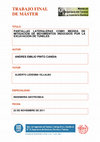Papers by Andres Quispe Candia

During the last decades, the construction of tunnels in urban areas has been increasing continuou... more During the last decades, the construction of tunnels in urban areas has been increasing continuously due to the need of new alternatives of transportation and underground infrastructure. The evaluation of ground displacements induced by tunnelling is one of the key challenges during the engineering design process, since this variable actually represents one of the main factors responsible for building and infrastructure damage. In practice, diaphragm walls are used as an alternative to mitigate ground movements and to prevent building damage. However, there are many handicaps when attempting to define its type, length, thickness, roughness and location, since there is limited information, research and case histories regarding this topic. In order to overcome these drawbacks, the design process needs to be based on a rational approach, including the variables affecting the problem and the empirical knowledge acquired during the construction works. Recently, centrifuge tests and numerical analyses have been performed to study the influence of diaphragm walls in the displacements field induced by tunnelling (Bilotta, 2004, 2008). Conclusions on this research highlighted the detrimental effect of the walls in reducing ground movements for certain conditions, contrary to the expectations. On the other hand, results from other studies report successful experiences obtained with the implementation of similar mitigation alternatives to control displacements in practice (Gens et al. 2006; Di Mariano et al. 2007; Oteo et al. 2007). The aim of this work is to assess the effectiveness of diaphragm walls in reducing ground movements induced by tunnelling. First, a parametric study is performed to evaluate the influence of the main variables affecting the field displacements. Subsequently, three case studies related to centrifuge models and the construction of tunnels for the high-speed railway system (AVE) in Barcelona city, are presented to validate the results obtained from the parametric analysis. Results showed that diaphragm walls as protective structures are effective in the control of ground movement. Finally, basic design criteria are proposed to optimize the performance of lateral walls in reducing surface displacements in engineering practice.
Uploads
Papers by Andres Quispe Candia